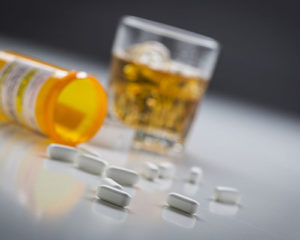Roche, the Switzerland-based multinational healthcare company, is one of the most profitable drug companies in the world. It ranked as the fourth-leading biotech and pharmaceutical company by profit in the world, raking in an estimated $10.5 billion in 2018, according to Statista, a market research company. Roche has an estimated market value of more than $250 billion, according to Reuters.
In 2015 alone, Roche produced three of the eight best-selling pharmaceutical products in Rituximab, Bevacizumab, and Trastuzumab, which are used to treat lymphoma, metastatic, and breast cancers. These blockbuster drugs have put Roche at the vanguard of addressing the global pandemic known as cancer, one of the most impacting and consequential groups of diseases of our times.
Nevertheless, the drugmaker is also responsible for introducing a class of potent, widely abused drugs known as benzodiazepines, depressant medications that primarily treat anxiety, panic disorders, and insomnia, among others. Benzos are highly addictive and can present deleterious effects, especially when they are taken with alcohol.
Read on to learn more about Roche, its role in introducing benzodiazepines and treatment options.
History of Roche
- Hoffman-La Roche & Co. was founded in 1896 by Fritz Hoffmann-La Roche, a Swiss businessman. Among its early successes, it became the first company to mass-produce Vitamin C. It would also go on to be the leading supplier of vitamins. However, it wasn’t until the mid-1950s that Roche chemist by the name of Leo Sternbach synthesized the first benzodiazepine chlordiazepoxide, which would later be marketed under the brand name Librium in 1960.
Three years after Librium, the drug maker would introduce Valium (generic name diazepam), a groundbreaking benzodiazepine medication that would become a generational answer to treating anxiety, muscle spasms, and seizures.
In 1962, Roche introduced Fluorouracil, its first anti-cancer drug which would help solidify its standing as an industry leader in cancer research and chemotherapy. In the ensuing years, the company would diversify its holdings across healthcare, developing electronic medical instruments, delving into medical publishing and diagnostics, and acquiring agrochemical holdings. Eventually, Roche would train its focus on biotechnology.
In addition, it would also manufacture several diabetes management products.
Aside from Valium, Roche’s most widely prescribed medications are:
- MabThera/Rituxan: Treats certain types of cancers and autoimmune diseases
- Avastin: Treats colorectal, kidney, glioblastoma, lung, cervical, and ovarian cancers
- Herceptin: Treats stomach, breast, and esophageal cancers
- Perjeta: Treats metastatic breast cancer
- Actemra/RoActemra: Treats moderate-to-severe rheumatoid arthritis
- Xolair: Treats asthma and hives
- Lucentis: Treats macular degeneration and macular edema caused by diabetes.
- Activase/TNKase: Treats acute cases of heart attack
- Tarceva: Treats pancreatic and non-small cell lung cancer
- Kadcyla: Treats breast cancer
The Effects of Roche’s Valium

Valium (diazepam) is one of the most widely known benzodiazepine medications. It is used to treat a variety of conditions, including anxiety, muscle spasms, seizure, and alcohol withdrawal. As a central nervous system (CNS) depressant, it works by boosting the amount of gamma-Aminobutyric acid (GABA) in the body, which works to increase mental and physical calm.
It can be taken by mouth, injected into a muscle or vein, or inserted into the rectum.
When larger doses of it are taken, or if it is taken longer than prescribed, its use is capable of producing euphoria.
Like any benzodiazepine, the side effects associated with Valium are like that of alcohol and other CNS depressants.
Valium produces the following side effects:
- Tiredness and fatigue
- Muscle weakness
- Impaired physical control and coordination
- Headache
- Tremors
- Dizziness
- Dry mouth
- Excessive saliva
- Nausea
- Constipation
In addition to those side effects, Valium can produce more severe ones that require medical attention:
- The appearance or worsening of seizures
- Depression
- Anxiety
- Confusion
- Vertigo
- Slurred or slowed speech
- Blurred or double vision
- Memory loss
- Suicidal thoughts
- Hallucinations
- Increased muscle spasms
- Trouble sleeping
- Liver problems
- Bladder problems
- Changes in sex drive
Valium Abuse Signs
A user can quickly build up a tolerance to Valium by taking a larger dose to experience the same effect that a previous, smaller dose yielded. That tolerance can grow into a Valium dependence, once a user stops and experiences withdrawal symptoms. What that means, according to the National Institute on Drug Abuse (NIDA) is that the body cannot function normally without the presence of Valium.
That dependence can quickly decline to addiction when a user begins to exhibit compulsive, drug-seeking behaviors where the obtaining Valium becomes the center of his or her life. They will begin to exhibit the following signs of addiction and abuse:
- You have developed a tolerance to the medication and need larger doses to achieve the same desired effects.
- You have been taking the drug for longer than you originally intended to.
- You have a constant desire to use the drug.
- You can’t decrease or stop your use even when you want to and try to do so.
- You spend a significant amount of time thinking about, obtaining, using, and recovering from the drug.
- You no longer participate in important events because of substance use.
- You continue to use the drug despite facing personal, professional, or legal problems.
- You are aware of the challenges the drug use is causing you, but you continue to use it.
When Valium Is Taken With Alcohol

When Valium is used with other alcohol and other drugs — a practice known as polysubstance abuse — the results can be deadly. Benzos are often taking with alcohol, another CNS depressant.
When someone ingests alcohol and Valium, they usually experience profound sedation. However, that sedation can slip into overdose, causing a user to experience life-threatening overdose symptoms.
The following symptoms can be signs of a diazepam overdose with alcohol:
- Low heart rate
- Slow heart rate
- Slow breathing
- Nausea
- Loss of coordination
- Loss of consciousness
- Coma
Professional Addiction Treatment
Prescription medications like Roche’s Valium have a tremendous utility in medical practice thanks to the various conditions they treat. However, it can induce addiction and set off adverse effects that only professional treatment can remedy.
A professional treatment program can provide a full range of comprehensive therapy, counseling, and support to break the cycle of addiction. When Valium is combined with alcohol, the withdrawal symptoms can be dangerous.
In treatment, you can get the Valium and other substances flushed from your body through acute treatment.
In a professional treatment program, those withdrawal symptoms can be alleviated safely and comfortably. Depending on the severity and nature of your prescription medication addiction, you can receive comprehensive therapy and counseling through clinical stabilization services or partial care.
You can also get connected with other people in recovery who can help you stay sober.

